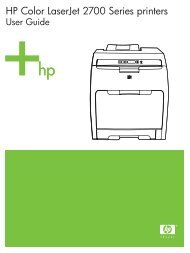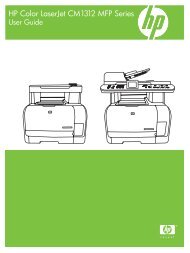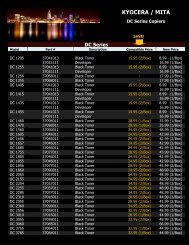HP LaserJet M1005 MFP user guide - ENWW
HP LaserJet M1005 MFP user guide - ENWW
HP LaserJet M1005 MFP user guide - ENWW
You also want an ePaper? Increase the reach of your titles
YUMPU automatically turns print PDFs into web optimized ePapers that Google loves.
Guidelines for using media<br />
The following sections provide <strong>guide</strong>lines and instructions for printing on transparencies, envelopes,<br />
and other special media. Guidelines and specifications are included to help you select media that<br />
optimizes print quality and avoid media that can cause jams or damage the device.<br />
Paper<br />
For best results, use conventional 80-g/m 2 or 20-lb paper. Make sure that the paper is of good quality<br />
and free of cuts, nicks, tears, spots, loose particles, dust, wrinkles, voids, and curled or bent edges.<br />
If you are unsure about what type of paper you are loading (such as bond or recycled), check the<br />
label on the package of paper.<br />
Some paper causes print quality problems, jamming, or damage to the device.<br />
Symptom Problem with paper Solution<br />
Poor print quality or toner adhesion<br />
Problems with feeding<br />
Too moist, too rough, too smooth, or<br />
embossed<br />
Try another kind of paper that has a<br />
smoothness rating of 100-250 Sheffield<br />
and has 4-6 % moisture content.<br />
Check the device and make sure that<br />
the appropriate media type has been<br />
selected.<br />
Dropouts, jamming, or curl Stored improperly Store paper flat in its moisture-proof<br />
wrapping.<br />
Increased gray background shading Might be too heavy Use lighter paper.<br />
Excessive curl<br />
Problems with feeding<br />
Too moist, wrong grain direction, or<br />
short-grain construction<br />
Use long-grain paper.<br />
Check the device and make sure that<br />
the appropriate media type has been<br />
selected.<br />
Jamming or damage to device Cutouts or perforations Do not use paper with cutouts or<br />
perforations.<br />
Problems with feeding Ragged edges Use good quality paper.<br />
NOTE The device uses heat and pressure to fuse toner to the paper. Make sure that any<br />
colored paper or preprinted forms use inks that are compatible with the f<strong>user</strong> temperature of<br />
200°C (392°F) for 0.1 second.<br />
Do not use letterhead that is printed with low-temperature inks, such as those used in some<br />
types of thermography.<br />
Do not use raised letterhead.<br />
Do not use transparencies that are designed for inkjet printers or other low-temperature<br />
printers. Use only transparencies that are specified for use with <strong>HP</strong> <strong>LaserJet</strong> printers.<br />
16 Chapter 3 Media specifications <strong>ENWW</strong>






